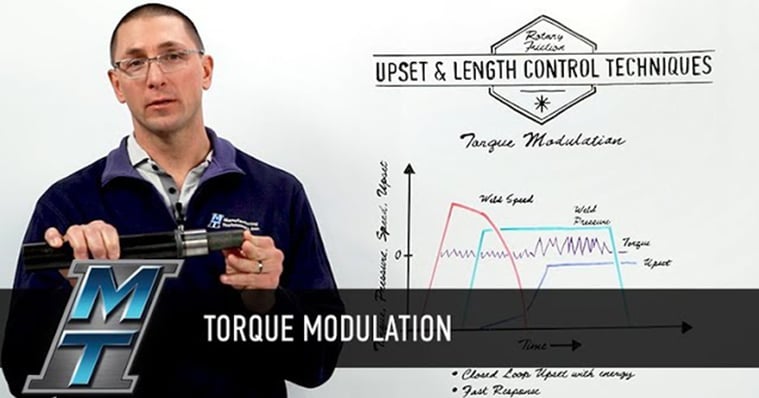
Our customers—especially those in the automotive industry—rely on repeatable upset in order to meet tight part tolerances. Remember, upset is the amount of shortening of the two parts as a result of friction welding.
A Quick Recap
In our last episode of Whiteboard Wednesday, we introduced Pressure Modulation. A relatively effective technique, Pressure Modulation is an indirect way to influence the amount of upset by modulating the amount of weld pressure used. Using this technique, we can vary our weld load to achieve repeatable upset time after time. This is done by closing the loop on upset, using the comparison of the current Inertia Weld Upset curve to a standard Inertia Weld Upset curve in order to generate an error signal that can be used to make process adjustments.
Remember, to generate an error signal, we follow these three steps:
- First, we create an upset profile by performing a standard inertia weld without the use of any control techniques, recording the amount of upset over time.
- Next, we perform a separate inertia weld using upset control techniques.
- Then, we compare the new weld to our upset profile in order to generate an error signal.
The error signal provides feedback to the welding control system, which then adjusts weld pressure until we have zero error signal between the new and profile welds.
It’s All About Torque
Torque Modulation uses this exact same principle. We create the same upset profile as before and compare it to the new weld in order to generate an error signal for closed loop control. But this time, we’re using torque instead of weld load to influence the formation of upset.
We do this by modulating the amount of torque that the rotary friction welder’s electric motor will apply. The electric motor is used to drive the spindle. In a typical inertia weld, there’s zero torque out of the electric motor, and the flywheels coast. But with Torque Modulation, we can apply torque with positive or negative adjustments to directly influence the amount of upset we form.
After all, Upset is directly proportional to the Energy input. Positive torque adds energy to the system, increasing upset, while negative torque applies braking and pulls energy out of the system, decreasing upset.
No More Error Band
Torque Modulation is a closed loop control technique that is at least 10x’s faster than using pressure modulation. This means we get at least 10x’s more adjustments over the course of the friction weld; more adjustments mean better repeatability, making Torque Modulation a much more accurate and repeatable form of upset control.
Just like with Pressure Modulation, Torque Modulation applies to all three types of rotary friction welding:
There’s Always Room for Improvement
While Torque Modulation is a very useful and repeatable form of upset control, keep in mind that there are a few limitations.
- We can only implement Torque Modulation when using an electric motor to drive the spindle.
- Our upset will always target the upset of our weld profile. This means that we achieve the same amount of upset regardless of the length of our incoming parts. So, Torque Modulation can’t be used to achieve a target length.
Stay tuned for our next episode of Whiteboard Wednesday where we’ll introduce an upset control technique that can either achieve a target upset between the two parts (different than the profile upset) or a target overall length of the part.
MTI Can Solve Your Problems
Our expert engineers have a deep understanding of friction welding processes and the wide variety of materials that can be used. With our knowledge and equipment, we know how to achieve the maximum utilization of each material to ensure you get the highest quality parts that are perfectly catered to your applications. We’ll build a machine that makes your part, we’ll make the part for you, or we’ll help you make the part even better. Contact us to get started.
 MTI UK
MTI UK  FWT
FWT